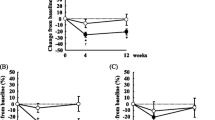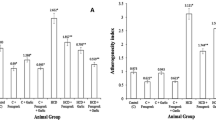Abstract
Flaxseed and sesame seed both contain more than 40% fat, about 20% protein, and vitamin E, mostly γ-tocopherol. Furthermore, both contain considerable amounts of plant lignans. However, flaxseed contains 54% α-linolenic acid, but sesame seed only 0.6%, and the chemical structures of flaxseed and sesame lignans are different. In this study, we investigated the differential effects of flaxseed and sesame seed on plasma and tissue γ-tocopherol, TBARS, and cholesterol concentrations. Rats were fed experimental diets for 4 wk: vitamin E-free, (-VE), γ-tocopherol, flaxseed (FS), sesame seed (SS), flaxseed oil (FO), FO with sesamin (FOS), and defatted flaxseed (DFF). SS and FOS diets induced significantly higher γ-tocopherol concentrations in plasma and liver compared with FS, FO, and DFF diets. Groups fed FS, FO, and FOS showed lower plasma total cholesterol compared with the SS and DFF groups. Higher TBARS concentrations in plasma and liver were observed in the FS and FO groups but not in the FOS groups. These results suggest that sesame seed and its lignans induced higher γ-tocopherol and lower TBARS concentrations, whereas flaxseed lignans had no such effects. Further, α-linolenic acid produced strong plasma cholesterol-lowering effects and higher TBARS concentrations.
Similar content being viewed by others
Abbreviations
- AIN:
-
American Institute of Nutrition
- γ-CEHC:
-
2,7,8-trimethyl-2(2′-carboxyethyl)-6-hydroxychroman
- DFF:
-
diet containing defatted flaxseed
- FO:
-
diet containing flaxseed oil
- FOS:
-
diet containing flaxseed oil and sesamin
- FS:
-
diet containing flaxseed
- MDA:
-
malondialdehyde
- SDG:
-
secoisolariciresinol diglycoside
- SS:
-
diet containing sesame seed
- T:
-
diet containing γ-tocopherol
- VE:
-
diet lacking vitamin E
References
Serraino, M., and Thompson, L.U. (1991) The Effect of Flaxseed Supplementation and Early Markers of Mammary Carcinogenesis, Cancer Lett. 60, 135–142.
Thompson, L.U., Seidl, M.M., Rickard, S.E., Orcheson, L.J., and Fong, H.H.S. (1996) Antitumorigenic Effect of a Mammalian Lignan Precursor from Flaxseed, Nutr. Cancer 26, 159–165.
Prasad, K. (1997) Dietary Flax Seed in Prevention of Hypercholesterolemic Atherosclerosis, Atherosclerosis 132, 69–76.
Yamashita, K., Nohara, Y., Katayama, K., and Namiki, M. (1992) Sesame Seed Lignans and γ-Tocopherol Act Synergistically to Produce Vitamin E Activity in Rats, J. Nutr. 122, 2440–2446.
Yamashita, K., Iizuka, Y., Imai, T., and Namiki, M. (1995) Sesame Seed and Its Lignans Produce Marked Enhancement of Vitamin E Activity in Rats Fed a Low α-Tocopherol Diet, Lipids 30, 1019–1028.
Parker, R.S., Sontag, R.S., and Swanson, J.E. (2000) Cytochrome P4503 A-Dependent Metabolism of Tocopherols and Inhibition by Sesamin, Biochem. Biophys. Res. Commun. 277, 531–534.
Sontag, T.J., and Parker, R.S. (2002) Cytochrome P450 ω-Hydroxylase Pathway of Tocopherol Catabolism. Novel Mechanism of Regulation of Vitamin E Status, J. Biol. Chem. 277, 25290–25296.
Ikeda, S., Tohyama, T., and Yamashita, K. (2002) Dietary Sesame Seed and Its Lignans Inhibit 2,7,8-Trimethyl-2(2′-carboxyethyl) 6-hydroxychroma Excretion into Urine of Rats Fed γ-Tocopherol, J. Nutr. 132, 961–966.
Baker, H., Handelman, G., Short, S., Machlin, L.J., Bhagavan, H.N., Dratz, E.A., and Frank, O. (1986) Comparison of Plasma α- and γ-Tocopherol Levels Following Chronic Oral Administration of Either all-rac-α-Tocopherol Acetate or RRR-α-Tocopherol Acetate in Normal Adult male Subjects, Am. J. Clin. Nutr. 43, 382–387.
Jiang, Q., Christen, S., Shigenaga, M.K., and Ames, B.N. (2001) γ-Tocopherol, the Major Form of Vitamin E in the US Diet, Deserves More Attention, Am. J. Clin. Nutr. 74, 714–722.
Wechter, W.J., Kantoci, D., Murray, E.D., Jr., D’Amico, D.C., Jung, M.E., and Wang, W.H. (1996) A New Endogenous Natriuretic Factor: LLU-α, Proc. Natl. Acad. Sci. USA 93, 6002–6007.
Cooney, R.V., Franke, A.A., Harwood, P.J., Hatch-Pigott, V., Custer, L.J., and Mordan, L.J. (1993) γ-Tocopherol Detoxification of Nitrogen Dioxide: Superiority to α-Tocopherol, Proc. Natl. Acad. Sci. USA 90, 1771–1775.
Christen, S., Woodall, A.A., Shigenaga, M.K., Southwell-Keely, P.T., Duncan, M.W., and Ames, B.N. (1997) γ-Tocopherol Traps Mutagenic Electrophiles Such As NOX and Complements α-Tocopherol: Physiological Implications, Proc. Natl. Acad. Sci. USA 94, 3217–3222.
Jiang, Q., Elson-Schwab, I., Courtemanche, C., and Ames, B.N. (2000) γ-Tocopherol and Its Major Metabolite, in Contrast to α-Tocopherol, Inhibit Cyclooxygenase Activity in Macrophages and Epithelial Cells, Proc. Natl. Acad. Sci. USA 97, 11494–11499.
Prasad, K. (1997) Hydroxy Radical-Scavenging Property of Secoisolariciresional Diglucoside (SDG) Isolated from Flaxseed, Mol. Cell Biochem. 168, 117–123.
Kitts, D.D., Yuan, Y.V. Wijewickreme, A.N., and Thompson, L.U. (1999) Antioxidant Activity of the Flaxseed Lignan Secoisolariciresinol Diglycoside and Its Mammalian Lignan Metabolites Enterodiol and Enterolactone, Mol. Cell Biochem. 202, 91–100.
Nakai, M., Harada, M., Nakahara, K., Akimoto, K., Shibata, H., Miki, W., and Kiso, Y. (2003) Novel Antioxidative Metabolites in Rat Liver with Ingested Sesamin, J. Agric. Food Chem. 51, 1666–1670.
Harris, W.S. (1997) n-3 Fatty Acids and Serum Lipoproteins: Animal Studies, Am. J. Clin. Nutr. 65 (Suppl.), 1611S-1616S.
Harris, W.S. (1997) n-3 Fatty Acids and Serum Lipoproteins: Human Studies, Am. J. Clin. Nutr. 65 (Suppl.), 1645S-1654S.
Kelly, D.S., Nelson, G.J., Love, J.E., Branch, L.B., Taylor, P.C., Schmidt, P.C., Mackey, B.E., and Lacono, J.M. (1993) Dietary α-Linolenic Acid Alters Tissue Fatty Acid Composition but Not Blood Lipids, Lipoproteins or Coagulation Status in Humans, Lipids 28, 533–537.
Prasad, K. (1997) Dietary Flax Seed in Prevention of Hypercholesterolemic Atherosclerosis, Atherosclerosis 132, 69–76.
Kim, H.-K., and Choi, H. (2001) Dietary α-Linolenic Acid Lowers Postprandial Lipid Levels with Increase of Eicosapentaenoic and Docosahexaenoic Acid Contents in Rat Hepatic Membrane, Lipids 36, 1331–1336.
Sugano, M., Inoue, T., Kobe, K., Yoshida, K., Hirose, N., Shinmen, Y., Akimoto, K., and Amachi, Y. (1990) Influence of Sesame Lignans on Various Lipid Parameters in Rats, Agric. Biol. Chem. 54, 2669–2673.
Hirose, N., Inoue, T., Sugano, M., Akimoto, K., Shimizu, S., and Yamada, H. (1991) Inhibition of Cholesterol Absorption and Synthesis in Rats by Seasamin, J. Lipid Res. 32, 629–638.
Prasad, K. (1999) Reduction of Serum Cholesterol and Hypercholesterolemic Atherosclerosis in Rabbits by Secoisolariciresinol Diglucoside from Flaxseed, Circulation 99, 1355–1362.
Bhathena, S.J., Ali, A.A., Mohamed, A.I., Hansen, C.T., and Velasquez, M.T. (2002) Differential Effects of Dietary Flaxseed Protein and Soy Protein on Plasma Triglyceride and Uric Acid Levels in Animal Models, J. Nutr. Biochem. 13, 684–689.
American Institute of Nutrition (1993) AIN-93 Purified Diets for Laboratory Rodents: Final Report of the American Institute of Nutrition Ad Hoc Writing Committee on the Reformulation of the AIN-76A Rodent Diet, J. Nutr. 123, 1939–1951.
Yamashita, K., Takeda, N., and Ikeda, S. (2000) Effects of Various Tocopherol-Containing Diets on Tocopherol Secretion into Bile, Lipids 35, 163–170.
Ueda, T., and Igarashi, O. (1987) New Solvent System for Extraction of Tocopherols from Biolgoical Specimens for HPLC Determination and the Evaluation of 2,2,5,7,8-Pentamethyl-6-chromanol as an Interal Standard, J. Micronutr. Anal. 3, 185–198.
Yagi, K. (1976) A Simple fluorometric Assay for Lipoperoxides in Plasma, Biochem. Med. 15, 212–216.
Ohkawa, H., Ohishi, N. and Yagi, K. (1979) Assay for Lipid Peroxides in Animal Tissues by Thiobarbituric Acid Reaction, Anal. Biochem. 95, 351–358.
Cooney, R.V., Custer, L.J., Okinaka, L., and Franke, A. (2001) Effects of Dietary Sesame Seeds on Plasma Tocopherol Levels, Nutr. Cancer 39, 66–71.
Lemcke-Norojarvi, M., Kamal-Eldin, A., Appelqvist, L.A., Dimberg, L.H., Ohrvall, M., and Vessby, B. (2001) Corn and Sesame Oils Increase Serum γ-Tocopherol Concentrations in Healthy Swedish Women, J. Nutr. 131, 1195–1201.
Author information
Authors and Affiliations
Corresponding author
About this article
Cite this article
Yamashita, K., Ikeda, S. & Obayashi, M. Comparative effects of flaxseed and sesame seed on vitamin E and cholesterol levels in rats. Lipids 38, 1249–1255 (2003). https://doi.org/10.1007/s11745-003-1185-7
Received:
Accepted:
Issue Date:
DOI: https://doi.org/10.1007/s11745-003-1185-7




